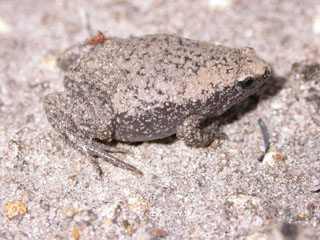
The Microhylidae, commonly known as narrow-mouthed frogs, are a geographically widespread family of frogs. The 683 species are in 57 genera and 11 subfamilies.

Physalaemus nattereri is a frog native to central and southeastern Brazil and eastern Bolivia and Paraguay.

The banded bullfrog is a species of frog in the narrow-mouthed frog family Microhylidae. Native to Southeast Asia, it is also known as the Asian painted frog, digging frog, Malaysian bullfrog, common Asian frog, and painted balloon frog. In the pet trade, it is sometimes called the chubby frog. Adults measure 5.4 to 7.5 cm and have a dark brown back with stripes that vary from copper-brown to salmon pink.

Rhinella scitula is a species of toads in the family Bufonidae. It is found in the southwestern Mato Grosso do Sul, Brazil, and in the adjacent southeastern Paraguay.

Melanophryniscus klappenbachi, also known as Klappenbach's red-bellied frog, is a South American species of toad in the family Bufonidae.
Ameerega braccata, formerly Epipedobates braccatus, is a species of frog in the family Dendrobatidae. It is endemic to the Central-West Region of Brazil and is known from southern Mato Grosso, Mato Grosso do Sul, and southwestern Goiás states; however, it is likely that its true range extends into adjacent Bolivia and Paraguay.
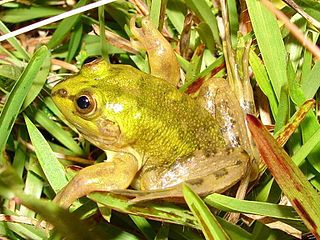
Pseudis cardosoi is a species of aquatic frog in the family Hylidae. It is endemic to southern Brazil and is known from the states of Rio Grande do Sul, Santa Catarina, and Paraná. The specific name cardosoi honors Adão José Cardoso, a Brazilian herpetologist.

Lithodytes is a genus of frogs in the family of Leptodactylidae. It is monotypic, being represented by the single species, Lithodytes lineatus, also commonly known as the gold-striped frog or painted antnest frog. It is found in tropical South America where it lives in humid forests among the leaf litter. These frogs build foam nests at the edge of temporary pools, and the tadpoles develop within these. The frogs also associate with certain leafcutter ants and breed inside their nests without being attacked by the ants.
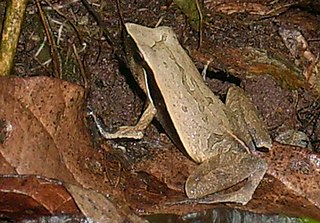
Physalaemus albonotatus is a species of frog in the family Leptodactylidae. It is found in Brazil, Paraguay, and Chacoan Argentina and Bolivia.

Breviceps adspersus, also known as common rain frog, bushveld rain frog, and many other vernacular names, is a species of frog in the family Brevicipitidae. It is found in Southern Africa, in Angola, Democratic Republic of the Congo, Namibia, Botswana, Zambia, Zimbabwe, South Africa, Eswatini, and Mozambique.

Chiasmocleis bassleri is a species of frog in the family Microhylidae. It is found in the Amazon biome of Brazil, Colombia, Ecuador, Peru, and Bolivia. The specific name bassleri honors Harvey Bassler, an American geologist and paleontologist. Common name Bassler's humming frog has been proposed for this species.

Chiasmocleis ventrimaculata, also known as the dotted humming frog, is a species of frog in the family Microhylidae. It is found in Bolivia, Brazil, Colombia, Ecuador, and Peru. Its natural habitats are subtropical or tropical moist lowland forests, swamps, and intermittent freshwater marshes.
Elachistocleis skotogaster is a species of frog in the family Microhylidae. It is known with certainty only from the Salta Province in northern Argentina. However, the type locality and some later observations are near the border to Bolivia, and it is possible that some frogs from Bolivia currently attributed to Elachistocleis ovalis belong to this species.

Stereocyclops histrio is a species of frog in the family Microhylidae. It is endemic to the northeastern Bahia state of Brazil where it occurs in remnants of the Atlantic forest. After the holotype was collected in 1944, the species went unrecorded until a population was found in the Una Biological Reserve and its surroundings in 1999. It is now known from four locations. Common name Bahia yellow frog has been coined for it, perhaps in reference to the bright lemon yellow coloration of the holotype. It was the only species in the genus Hyophryne until 2012 when molecular data demonstrated that it is nested within Stereocyclops species.

Myersiella is a genus of frogs in the family Microhylidae. It is monotypic, being represented by the single species, Myersiella microps. It is endemic to southeastern Brazil and occurs in Espírito Santo, Rio de Janeiro, southeastern Minas Gerais, and southeastern São Paulo state. The genus name honors George S. Myers. The genus is sometimes known as the elongated frogs, while the sole species is known as Rio elongated frog.

Phrynomantis microps is an African frog with many interesting adaptations to the savannah. These frogs are also called the Accra snake-necked frog. They are found across Western and Central Africa. One of its distinguishing features is the peptide secretion on its skin, which goes beyond toxicity and seems to inhibit aggressive behavior like biting and stinging from large ants. This allows Phrynomantis microps to live in humid burrows within large ant nests and termite mounds, where they are frequently found. While Phrynomantis microps feeds on similar insects such as the termite Macrotermes bellicosus, they have never been found to feed on the ants they share the nest with. These frogs are medium-sized and have a bright red pelvic region.
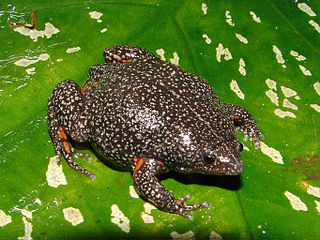
Elachistocleis pearsei is a species of frog in the family Microhylidae. It is found in the Pacific versant of western Costa Rica, Panama, Caribbean lowlands of Colombia and into the Magdalena River Valley, and in northwest Venezuela. The specific name pearsei honors Arthur Sperry Pearse, an American zoologist.

The Mato Grosso antbird is a species of bird in subfamily Thamnophilinae of family Thamnophilidae, the "typical antbirds". It is found in Bolivia, Brazil, and Paraguay.
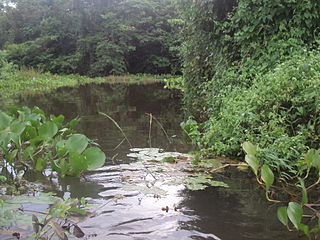
The Pantanal Matogrossense National Park is a national park in the state of Mato Grosso at the border to Mato Grosso do Sul, Brazil.

Serra da Bodoquena National Park is a national park in the state of Mato Grosso do Sul, Brazil.


















